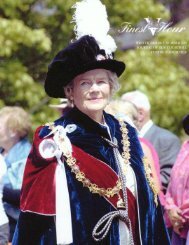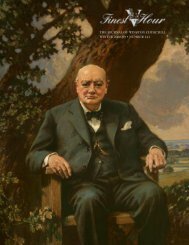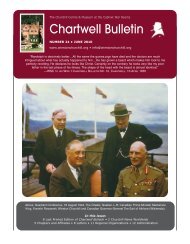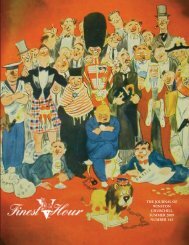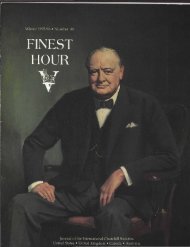You also want an ePaper? Increase the reach of your titles
YUMPU automatically turns print PDFs into web optimized ePapers that Google loves.
William Tritton of William Foster & Co. Ltd. ofLincoln to produce a small “landship.” Built in secrecy,the machine was given the code-name and referred to asa “water tank for Mesopotamia”—partly because of itsappearance, partly to keep its true nature secret. Thusthe name “tank.” 12Holt did not build tanks for Britain; those eventuallyproduced were of British production. But it was theHolt design and track laying caterpillar system, accordingto Swinton, that sparked the development of Britishtanks. 13On 20 January 1916 the first British tank began itstrials. More than a year earlier, <strong>Churchill</strong> had encouragedthe inventors and technical experts to work out aneffective design; when the War Office showed no interest,<strong>Churchill</strong> had found Admiralty money to fund theexperiments. He had also encouraged those whobelieved, as he did, that the tank could effectively endtrench warfare, substantially lessening the casualties inFrance and Flanders. 14Tanks were used for the first time in battle on theSomme, where a dramatic turn in the Entente (Allied)fortunes took place on 15 September 1916. Forty-ninetanks took part in the attack, moving forward on a widefront. Ten were hit by German artillery fire, nine brokedown with mechanical difficulties, and five failed toadvance. The rest advanced more than 2000 yards, capturingthe long-sought High-Wood, and three villages,Flers, Martinpuich, and Courcelette. But a disappointed<strong>Churchill</strong> wrote to Admiral Fisher, both of them nowout of power: “My poor ‘land battleships’ have been letoff prematurely and on a petty scale. In that idea residedone real victory.” 15<strong>Churchill</strong> had wanted to produce tanks in largenumbers, and only deploy them when as many as 1000were available. Recognizing the potential of the newweapon, British Commander General Haig asked theWar Office for a thousand. The Germans, fortunately,were far behind in their own tank experiments.As the tanks helped the British advance, RaymondAsquith, the Prime Minister’s son, was shot through thechest and died. Also wounded that day was the futurePrime Minister Harold Macmillan, who lived out his lifewith bullet fragments embedded in his pelvis, whichgave him a “shuffling walk.” During the day he waswounded, Macmillan recalled seeing a tank, one of“these strange objects,” bogged down in a shell-hole. 16The tank quickly proved its worth, even in smallnumbers. Eleven days after its first use, an attack by thirteentanks captured the village of Thiepval, which hadheld out since the first day of the Somme offensive. Thatsame day, Combles fell to an infantry attack supportedby two tanks, while at Gueudecourt, where tanks wereassisted by air reconnaissance, 500 Germans were takenprisoner with only five British casualties.The new invention was not without its problems.In muddy conditions tanks becamestuck and almost completely useless.Deployment methods and tank use in themilitary arts had not evolved very far, and to use them inthe wrong way would actually hinder a battle. TheFrench used tanks for the first time on 17 April 1917,when Gen. Nivelle planned to advance six miles usingtwenty divisions along a 25-mile front along the riverAisne. The attack was a disaster; his men halted afteronly six hundred yards. Expecting 15,000 casualties,Nivelle wound up with 100,000. Of the 128 tanks usedin the battle, thirty-two were knocked out on the firstday. Two villages in the battle zone, Nauroy andMoronvillers were totally destroyed. 17Far to the south and east in Palestine, meanwhile,the British launched their second attempt to captureGaza. Despite eight tanks, the use of gas shells, and atwo-to-one troop preponderance, this attack was a failure,but Gaza fell to Allenby’s troops on 1 November1917, the tanks doing everything that was expected ofthem despite harsh desert conditions.By mid-May 1917, Haig’s troops had made greateradvances than at any time since the start of trench warfaretwo and a half years earlier: 61 square miles ofGerman-held territory, over 20,000 prisoners of war, and252 heavy guns were taken in just over a month. Thetank had become an integral part of British infantry, andthe results were telling. The first German tank trial washeld only that month, on 14 May at Mainz, two daysbefore the renewed Battle of Arras ended. The Germanshad finally learned to appreciate this new weapon.On 10 August 1917, the British renewed the Ypresoffensive, but the advance was impeded four days laterby heavy rain. On the 16th the village of Langemarckwas taken, but a German counter-attack recovered muchof the gains. The initiative lay, however, with the British,who were helped in capturing the fortified German pillboxesby the use of tanks, and also by a ferocious Frenchdiversionary attack on the German lines at Verdun,when more than 5,000 Germans were taken prisoner.On 23 October along the Aisne, the Frenchlaunched a limited but sustained attack on German positionsdefending the Chemin des Dames, assisted byeighty French tanks. They advanced two miles across thepulverized terrain, taking 10,000 prisoners and deprivingthe enemy of an important observation point at Laffaux.Among the places captured by the French was the Fort dela Malmaison, a former fortress which had been soldbefore the war to a private builder, for use as a stonequarry. Known as the Battle of the Quarries, the victorywas what one historian has called “neat and compact andsatisfying as a gift package; indeed a gift to cheer a tiredand discouraged country.” The Germans, unwilling to >>FINEST HOUR 135 / 47





